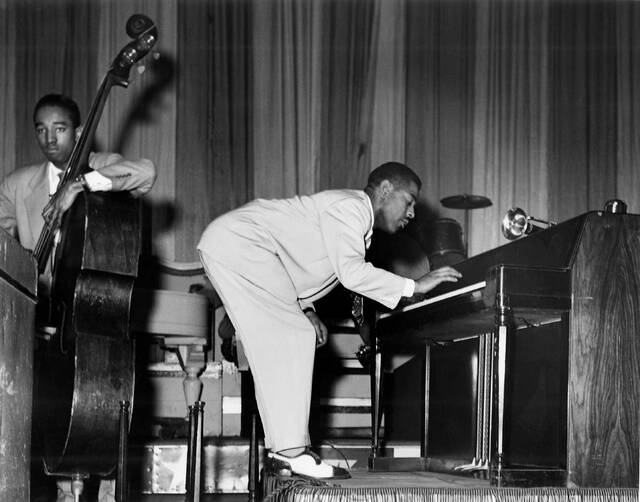https://triblive.com/aande/museums/black-photojournalism-exhibit-at-carnegie-museum-of-art-reveals-history-through-many-lenses/
‘Black Photojournalism’ exhibit at Carnegie Museum of Art reveals history through many lenses

A picture is worth a thousand words, but for Black photojournalists during the 20th century, many of those words were spoken in whispers.
A new exhibit from the Carnegie Museum of Art in Oakland seeks to bring the work of these professionals to the forefront.
Much of the inspiration for the new exhibit — which opens Sept. 13 and will be on display through Jan. 19 in the Heinz Galleries — came from the archive of Charles “Teenie” Harris, a Black photojournalist from Pittsburgh’s Hill District whose four decades of work have gained national recognition.
“We started thinking about a network or a constellation that Harris was a part of,” said Dan Leers, co-organizer of “Black Photojournalism” and curator of photography at the Carnegie Museum of Art.
The collection on display in “Black Photojournalism” encompasses the time period from the end of World War II to the presidential election campaign of 1984, when Civil Rights activist Jesse Jackson ran.
According to Leers, the post-war period represented a boom in Black-owned media.
“I think part of that was fueled by a readership of Black men and women who had served overseas to fight the Axis enemies and to obtain equal rights for people in Europe, who were then returning home and feeling like they were being treated unfairly,” he said.
Magazines such as “Ebony” and “Jet” would be founded in the mid-century period, and Black newspapers, including the Pittsburgh Courier, the Chicago Defender and the Baltimore Afro-American, flourished, all with the integral contributions of their photojournalists.
The Carnegie’s exhibit features the work of nearly 60 photographers with a range of subjects from political figures to historical events to pop culture icons.
With the setup and flow of the exhibit, viewers can follow the path chronologically, but there’s always a chance to look closer into the elements that catch the eye.
“We also have a number of cases and AV elements that will provide opportunities to delve deeper into specific regional publications or specific themes,” Leers said.
They also have equipment, such as microfiche and carousel projectors, that fit with the technology of the time periods, according to Charlene Foggie-Barnett, co-organizer of the exhibit and Charles “Teenie” Harris community archivist for the Carnegie Museum of Art.
“That helps us separate the themes. Some of the themes include, obviously, civil rights and politics, but also things like the women’s movement and women’s role in politics. We talk about various types of industry, music, sports and fashion,” she said.
There’s more to it, though — not only do these photographs record the big moments that made history, but they also reveal moments of everyday life from people who were often ignored.
“This is the proof of the community,” Foggie-Barnett said. “This is the proof of how the Black community across the country actually lived. And there’s not much division between the North to South or east to west. … Oftentimes, publications — especially traditional newspapers — would want to run what I call ‘gritty’ or a more downtrodden story about the Black community, and what these other publications offer is not only a hopeful but a realistic photo of how African-Americans actually lived in the country.”
This includes shots highlighting fraternal organizations, churches, clubs and sports teams.
“The Black photographers and journalists knew to look deeper,” Foggie-Barnett said.
They made an effort in the composition of the exhibit to put the photos into a historical context.
“The birthday parties and the weddings and the funerals, those are life moments that apply to all humanity. It’s just that those were not traditionally being pictured on the pages of White-owned newspapers and magazines,” Leers said.
He said that they made an effort to show less-seen images in this collection.
“Black Photojournalism” allowed its organizers to peer into the collections of publications, libraries and museums all over the country — and learn from other passionate professionals who were on a similar journey.
Luckily, many of the photojournalists featured in the upcoming show are still with us, and several will appear at the free opening celebration on Sept. 13. The event will include light refreshments, a panel discussion and guided tours of the brand-new exhibit.
In addition to the show itself, they produced a six-part podcast focusing on different geographies of Black photojournalism hosted by writer Mark Whittaker, according to Leers. There will also be contemporary art projects accompanying the exhibit, including a newspaper takeaway project and a set of fabric books.
There is also a publication that goes along with the exhibit that includes an interview between Foggie-Barnett and local author Damon Young about the process of community archiving.
“This is a way of us acknowledging that the taking of these pictures and the coverage of these events has not stopped during this time period. Yes, we are looking at one very specific moment, but of course, many of these pictures and the content they include are just as relevant as they were when they were made 70-plus years ago. We really wanted to make people feel like this was a contemporary project,” Leers said.
“Black Photojournalism” will open in the Heinz Galleries of the Carnegie Museum of Art in Oakland on Sept. 13. The opening celebration will be held at 10 a.m. To learn more, visit carnegieart.org.
Copyright ©2026— Trib Total Media, LLC (TribLIVE.com)
